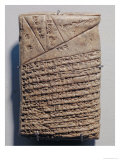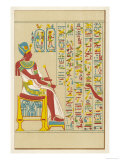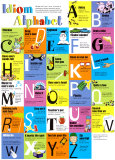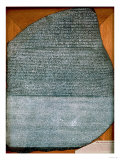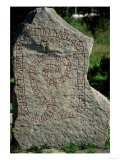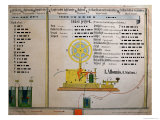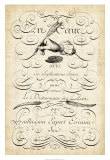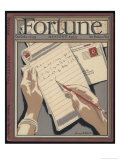|
|
|
|
|
Calligraphy, from the Greek ‘kalligraphia’ which means beautiful writing, refers to writing that conveys meaning through design as well as stringing a line of glyphs together. The detail of the illuminated text is an example of a style of lettering developed c. 12th century Europe known as Gothic (from the East Germanic language of the Goths circa 4th-6th centuries) and was practiced by the learned monks as a means of copying existing manuscripts (documents written by hand) prior to the advent of moveable type.
When the text of a manuscript is supplemented with emblished initials, borders and illustrations, it is refered to as illuminated because of the medieval practice of using gold and silver to bring “light” to the page.
The Book of Kells, perhaps the most noted illuminated manuscript, was produced by Celtic monks around AD 800 and contains the four gospels of the Bible in Latin.
• more Middle Ages posters
|
|
|
|
The cuneiform (q-knee-a-form), a script that gets its name from the wedge shaped impressions left by a reed stylus in a clay tablet (L. cuneus = wedge), is one of the earliest known writing systems.
Over the course of several thousand years the pictograph system devised by the Sumerian (c. 3000 BC), was simplified and abstracted. In due course cuneiform was adapted by many cultures and inspired national alphabets. Cuneiform was gradually supplanted by Aramaic.
• Middle East posters
• Cuneiform: Reading the Past
|
|
|
|
|
|
|
An ideogram is a graphic symbol representing an idea.
An illustration or photograph of an object is not an ideogram.
Subcultures such as hobos and gypsies used symbols to alert fellow travellers as to what they  could expect when they came into an unfamiliar area. For instance the hobo sign that resembled a couple of closely spaced ws would get the idea of ‘beware of the dog’ across to the next hobo. could expect when they came into an unfamiliar area. For instance the hobo sign that resembled a couple of closely spaced ws would get the idea of ‘beware of the dog’ across to the next hobo.
• Indispensable Outcasts: Hobo Workers and Community in the American Midwest, 1880-1930
|
|
|
|
Idioms are “figures of speech”, expressions whose meaning can't be deduced from literal definitions: “apple of your eye” someone or something that is very special to you, or “bite the dust” for dying.
|
|
|
|
Pictographs are drawn symbols representing and resembling a concept, object, activity, place or event, by illustration. In contrast a petroglyph is a symbol carved into a rock, and an ideogram represents an idea.
Pictographs, which predate cuneiform and hieroglyphs, are also common today as signs and instruction in public places (restroom facilities, campgrounds) and as warning for hazards.
Some Latin characters have evolved from pictorgrams- for instance the letter H which came from the Egyptian hieroglyph for fence.
|
|
|
|
The Phoenician writing system was widely spread by merchants around the Mediterranean area; the Greek, Latin, Cyrillic, Coptic alphabets, as well as scripts used in modern India, SE Asia, Tibet, and Mongolia, evolved from the Phoenician. Phoenician is classified as Semetic, along with Arabic, Aramaic, and Hebrew; the term Semetic is after Shem, the son of Noah.
|
|
|
|
The Rosetta Stone, a stele from the Ptolemaic era (c 196 BC), was discovered in the Egyptian Mediterranean coastal city of Rosetta in 1799 by the the French, and has been kept in the British Museum since 1802.
The texts of the Rosetta Stone is a decree repealing taxes and erection of temple statues. The value of the Rosetta Stone lay in the mundane content being written in three different language scripts: hieroglyphic and Demotic Egyptian, and in classical Greek. In a process similar to learning foreign languages by comparing the multi-language text of technical manuals, Frenchman Jean-François Champollion deciphered previously undecipherable ancient writing.
|
|
|
|
Runes are letters used to write Germanic languages prior to and shortly after the Christianization of the British Isles and Scandinavia.
Odin, the chief god in the Norse pantheon, is credited with the invention of runes; among his many roles is wisdom, death, and poetry.
Runes have come to be used in divination, fantasy games and literature. Author J.R.R. Tolkien's constructed a runic script as part of the story in ‘The Hobbit’ and ‘The Lord of the Rings’.
|
|
|
|
Telegraphy, from the Greek tele = far and graphein = write, is the transmission of written messages over long distances without physically transporting the message. Smoke signals, beacons, and semaphore are examples of optical telegraphy, however their effectiveness was dependent of time of day and weather conditions.
Samuel F. B. Morse and his assistant Alfred Vail developed an electric telegraph and a code of dots and dashes representing letters, numerals, punctuation and special characters, that was patented in the US in 1837. The first transatlantic telegraph cable completed in 1866, the Pacific cable was completed in 1902.
Wireless communication, or radio, was successfully demonstrated by several people at the turn of the 20th Century. Guglielmo Marconi is generally attibuted with sending and receiving radio signals in Italy in 1896.
• more inventions posters
• Your Introduction to Morse Code
|
|
|
|
|
|
|
Stenography, the “abbreviated symbolic writing method that increases speed or brevity” was used as early as the ancient Greeks, Romans, and Chinese.
|
|
|
previous page | top | alphabets, letters & numbers posters 1 | 2 | 3
|
|
I have searched the web for visual, text, and manipulative curriculum support materials - teaching posters, art prints, maps, charts, calendars, books and educational toys featuring famous people, places and events - to help teachers optimize their valuable time and budget.
Browsing the subject areas at NetPosterWorks.com is a learning experience where educators can plan context rich environments while comparing prices, special discounts, framing options and shipping from educational resources.
Thank you for starting your search for inspirational, motivational, and educational posters and learning materials at NetPosterWorks.com. If you need help please contact us.
|
|
|








